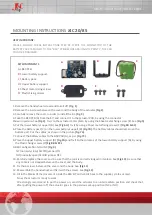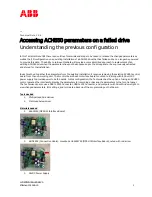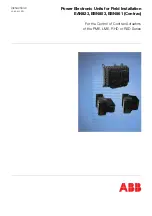
5. Supply compressed air and close the process valve. The pistons move to the
outer end position.
6. Check the position of the process valve. If necessary, repeat steps 1-5.
7. If the desired position is found, check whether both adjusting screws offer res-
istance to the pistons in a closed process valve position:
8. Switch off pressure to the quarter turn actuator
.
9. Loosen the lock nuts
2
(
Fig. 2).
10. If necessary, screw in loose adjusting screws until light resistance is felt.
11. Tighten the lock nuts
2
(
Fig. 2) again.
12. Supply compressed air and test the adjustment for some cycles.
13. Check the position of the process valve. If necessary, repeat steps 1-12.
2.2 Single-acting actuators
Note
• Test adjustment of the piston stops with minimum air pressure.
DAPS-1440..RS..-F
1 2
3
4
5
1
Adjusting screw (shutting angle)
2
Lock nut (shutting angle)
3
Drive shaft (here, process valve
closed)
4
Lock nut (opening angle)
5
Adjusting screw (opening angle)
Fig. 3
End-position adjustment DAPS-1440..RS..-F
Adjustment of the opening angle
1. Switch off pressure to the quarter turn actuator. The process valve is closed.
2. Loosen the lock nuts
4
(
Fig. 3).
3. Adjust the end position:
– To reduce the opening angle (<90°), turn the adjusting screw
5
(
Fig. 3)
clockwise.
– To increase the opening angle (>90°), turn the adjusting screw
5
anti-clockwise.
4. When you have finished the adjustment, tighten the lock nut
4
(
Fig. 3)
again.
5. Supply compressed air and open the process valve. The piston moves to the
outer end position.
6. Check the position of the process valve. If necessary, perform steps 1-4 again.
7. Supply compressed air and test the adjustment for some cycles.
8. Check the position of the process valve. If necessary, repeat steps 1-7.
Adjustment of the shutting angle
1. Supply compressed air and open the process valve. The pistons move to the
outer end position.
2. Loosen the lock nut 2.
3. Adjust the end position:
– To reduce the shutting angle (<0°), turn the adjusting screw
1
(
Fig. 3)
clockwise.
– To increase the shutting angle (>0°), turn the adjusting screw
1
anti-clockwise.
4. When you have finished the adjustment, tighten the lock nut
2
(
Fig. 3)
again.
5. Switch off pressure to the quarter turn actuator and vent it. The process valve
closes by means of spring return.
6. Check the position of the process valve. If necessary, repeat steps 1-5.
DAPS-1920..RS..-F, DAPS-2880..RS..-F, DAPS-4000..RS..-F
4
5
1 2
3
1
2
1
Adjusting screw (opening angle)
2
Lock nut (opening angle)
3
Drive shaft (here, process valve
closed)
4
Adjusting screw (shutting angle)
5
Protective cap (shutting angle)
Fig. 4
End-position adjustment DAPS-1920..RS..-F, DAPS-2880..RS..-F,
DAPS-4000..RS..-F
Adjustment of the opening angle
1. Switch off pressure to the quarter turn actuator. The process valve is closed.
2. Loosen the lock nuts
2
(
Fig. 4).
3. Adjust the end position:
– To reduce the opening angle (<90°), turn the adjusting screws
1
(
Fig. 4)
clockwise.
– To increase the shutting angle (>90°), turn the adjusting screw
1
anti-clockwise.
Note
Improper handling can result in malfunctions.
• Turn the adjusting screws uniformly, so that the pistons stop in the same end
position.
4. When you have finished the adjustment, tighten the lock nuts
2
(
Fig. 4)
again.
5. Supply compressed air and open the process valve. The pistons move to the
outer end position.
6. Check the position of the process valve. If necessary, repeat steps 1-5.
7. If the desired position is found, check whether both adjusting screws offer res-
istance to the pistons in an open process valve position:
8. Loosen the lock nuts
2
(
Fig. 4).
9. If necessary, screw in loose adjusting screws until resistance is felt.
10. Tighten the lock nuts
2
(
Fig. 4) again
11. Supply compressed air and test the adjustment for some cycles.
12. Check the position of the process valve. If necessary, repeat steps 1-11.
Adjustment of the shutting angle
1. Supply compressed air and open the process valve. The pistons move to the
outer end position.
2. Remove protective cap
5
(
Fig. 4).
3. Adjust the end position:
– To increase the shutting angle (>0°), turn the adjusting screw
4
(
Fig. 4)
clockwise.
– To reduce the shutting angle (<0°), turn the adjusting screw
4
anti-clockwise.
4. Supply compressed air and test the adjustment for some cycles.
5. Check the position of the process valve. If necessary, repeat steps 1-4.
6. When you have finished the adjustment, secure the lock nut
5
(
Fig. 4)
again.






















